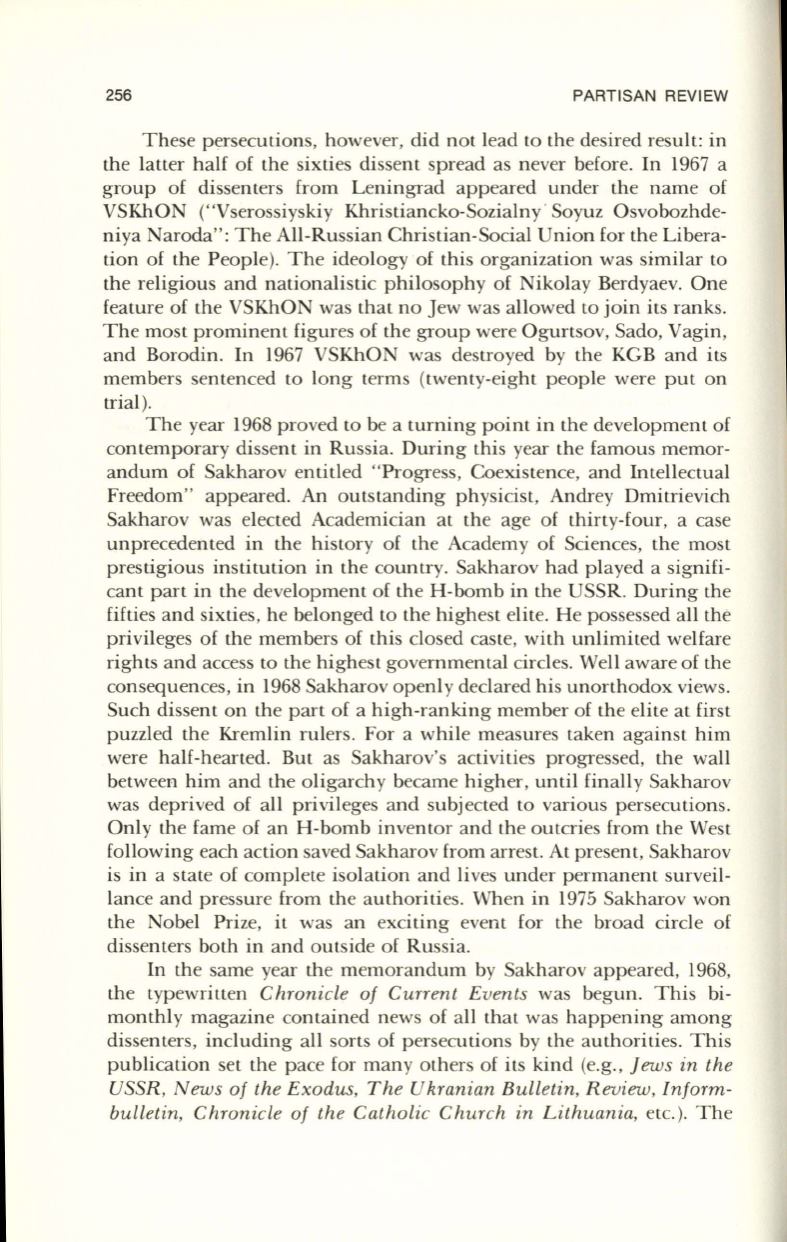
256
PARTISAN REVIEW
These persecutions, however, did not lead to the desired result: in
the latter half of the sixties dissent spread as never before.
In
1967 a
group of dissenters from Leningrad appeared under the name of
VSKhON ("Vserossiyskiy Khristiancko-Sozialny Soyuz Osvobozhde–
niya Naroda": The All-Russian Christian-Social Union for the Libera–
tion of the People). The ideology of this organization was similar
to
the religious and nationalistic philosophy of Nikolay Berdyaev. One
feature of the VSKhON was that no Jew was allowed to join its ranks.
The most prominent figures of the group were Ogurtsov, Sado, Vagin,
and Borodin.
In
1967 VSKhON was destroyed by the KGB and its
members sentenced to long terms (twenty-eight people were put on
trial ).
The year 1968 proved
to
be a turning point in the development of
contemporary dissent in Russia. During this year the famous memor–
andum of Sakharov entitled "Progress, Coexistence, and Intellectual
Freedom" appeared. An outstanding physicist, Andrey Dmitrievich
Sakharov was elected Academician at the age of thirty-four, a case
unprecedented in the history of the Academy of Sciences, the most
prestigious institution in the country. Sakharov had played a signifi–
cant part in the development of the H-bomb in the USSR. During the
fifties and sixties, he belonged to the highest elite. He possessed all the
privileges of the members of this closed caste, with unlimited welfare
rights and access to the highest governmental circles. Well aware of the
consequences, in 1968 Sakharov openly declared his unorthodox views.
Such dissent on the part of a high-ranking member of the elite at first
puzzled the Kremlin rulers. For a while measures taken against him
were half-hearted. But as Sakharov's activities progressed, the wall
between him and the oligarchy became higher, until finally Sakharov
was deprived of all privileges and subjected to various persecutions.
Only the fame of an H-bomb inventor and the outcries from the West
following each action saved Sakharov from arrest. At present, Sakharov
is in a state of complete isolation and lives under permanent surveil–
lance and pressure from the authorities. When in 1975 Sakharov won
the Nobel Prize, it was an exciting event for the broad circle of
dissenters both in and outside of Russia.
In
the same year the memorandum by Sakharov appeared, 1968,
the typewritten
Chronicle of Current Events
was begun. This bi–
monthly magazine contained news of all that was happening among
dissenters, including all sorts of persecutions by the authorities. This
publication set the pace for many others of its kind (e.g. ,
Jews in the
USSR, News of the Exodus, The Ukranian Bulletin, Review, Inform–
bulletin, Chronicle of the Catholic Church in Lithuania,
etc.). The


